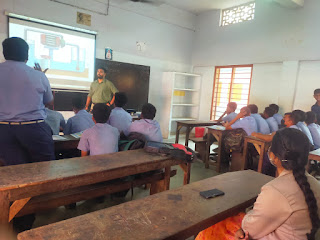Teaching Practice Reflection: Exploring Series and Parallel Connections in Class 9 Physics at St. Mary's HSS Pattom
eaching practice is a crucial part of a student teacher's journey towards becoming a skilled educator. Each day presents unique challenges and learning opportunities. On the ninth day of my teaching practice at St. Mary's HSS Pattom, I had the privilege of teaching Class 9 Physics, focusing on series and parallel connections. In this blog, I will share my experiences, the teaching methods I used, and the supporting tasks I performed on that memorable day.
The Lesson: Series and Parallel Connections
The day began with a sense of anticipation as I prepared to teach the fourth period, Class 9 Physics. My objective was to make the topic of series and parallel connections engaging and understandable for the students. To achieve this, I incorporated interesting videos and images into the lesson. These multimedia elements helped to visually demonstrate the concepts and engage the students' attention.
Teaching Methodology:
Introduction and Visualization: I started the lesson with a brief introduction to series and parallel connections, followed by a thought-provoking question to pique the students' curiosity. To enhance understanding, I used images and animations to illustrate the concepts.
Interactive Discussion: I encouraged students to actively participate by asking questions and sharing their thoughts. We discussed real-life examples to relate the topic to their daily experiences.
Working Models: To make the lesson more interactive, I presented working models of series and parallel connections. These physical demonstrations allowed students to see the principles in action and provided a tactile learning experience.
Videos: I integrated educational videos that showcased practical applications of series and parallel connections. These videos not only reinforced the concepts but also made the lesson enjoyable.
Review Questions:
To ensure comprehension and stimulate critical thinking, I provided the following review questions for the students:
What is the fundamental difference between a series and parallel circuit?
Can you provide an example of a series circuit commonly found in households?
Why is it important to understand series and parallel connections in electrical circuits?
Explain how voltage and current behave in a series circuit.
Describe a scenario where a parallel connection is more practical than a series connection.
Follow-Up Activities:
To reinforce their learning and encourage independent exploration, I assigned the following follow-up activities:
Design a simple series circuit using household items and draw its schematic diagram.
Create a parallel circuit using batteries, bulbs, and wires, and record the differences in brightness between bulbs.
Research and present a real-world application of series and parallel connections, such as in household wiring or electronic devices.
Supporting Tasks:
In addition to teaching my own class, I also contributed to my batchmate's teaching experience by taking videos and photos during their health education class. This collaborative effort helped us gain a deeper insight into each other's teaching methods and provided valuable feedback for improvement.
Conclusion:
The ninth day of my teaching practice at St. Mary's HSS Pattom was a fulfilling experience. Engaging the students with multimedia elements, hands-on demonstrations, and interactive discussions made the topic of series and parallel connections come alive. The review questions and follow-up activities aim to solidify their understanding and encourage further exploration. Teaching practice is not just about imparting knowledge; it's also about inspiring young minds and facilitating their growth as learners.

.jpeg)

.jpeg)
.jpeg)
.jpeg)

.jpeg)
.jpeg)
.jpeg)


Comments
Post a Comment